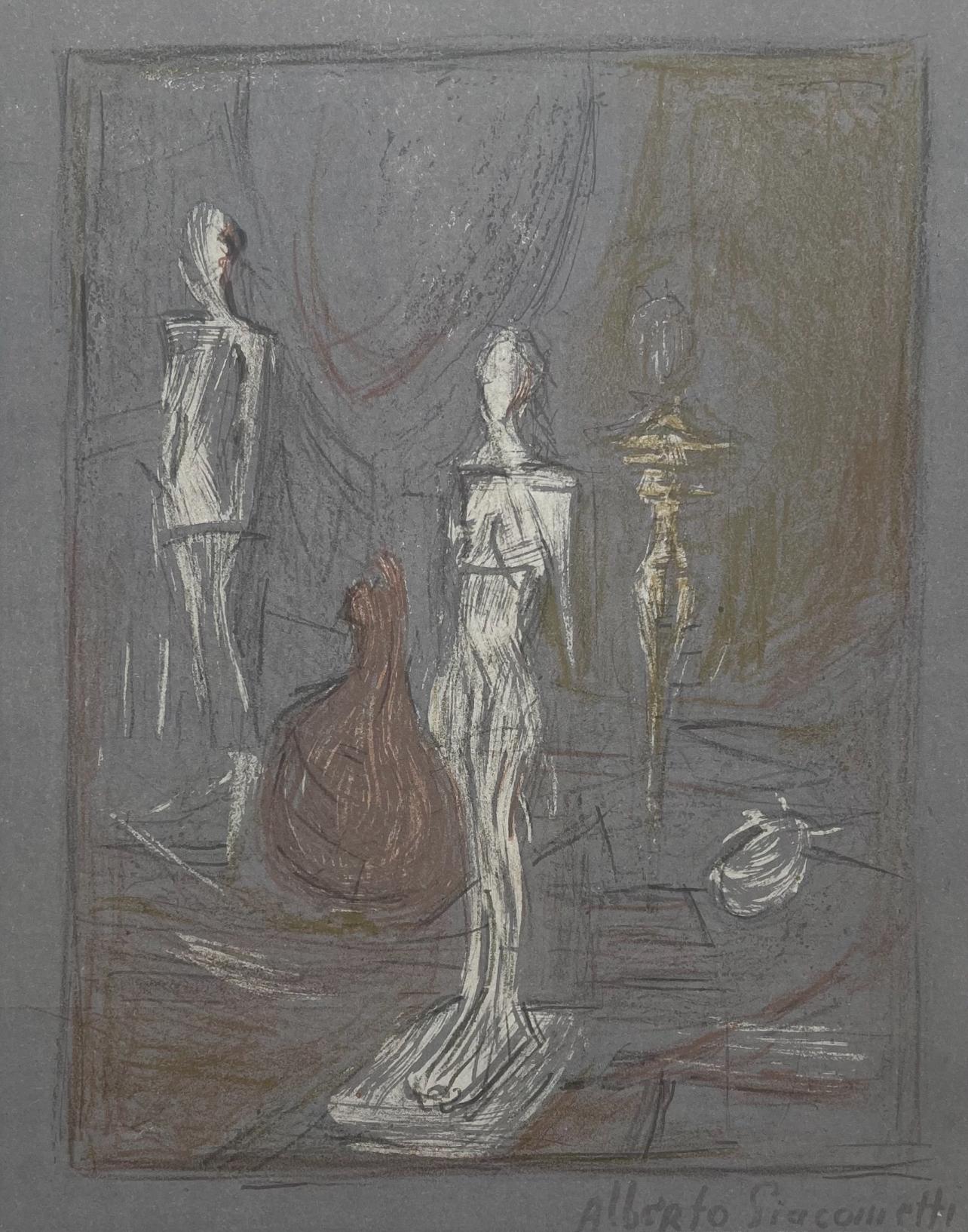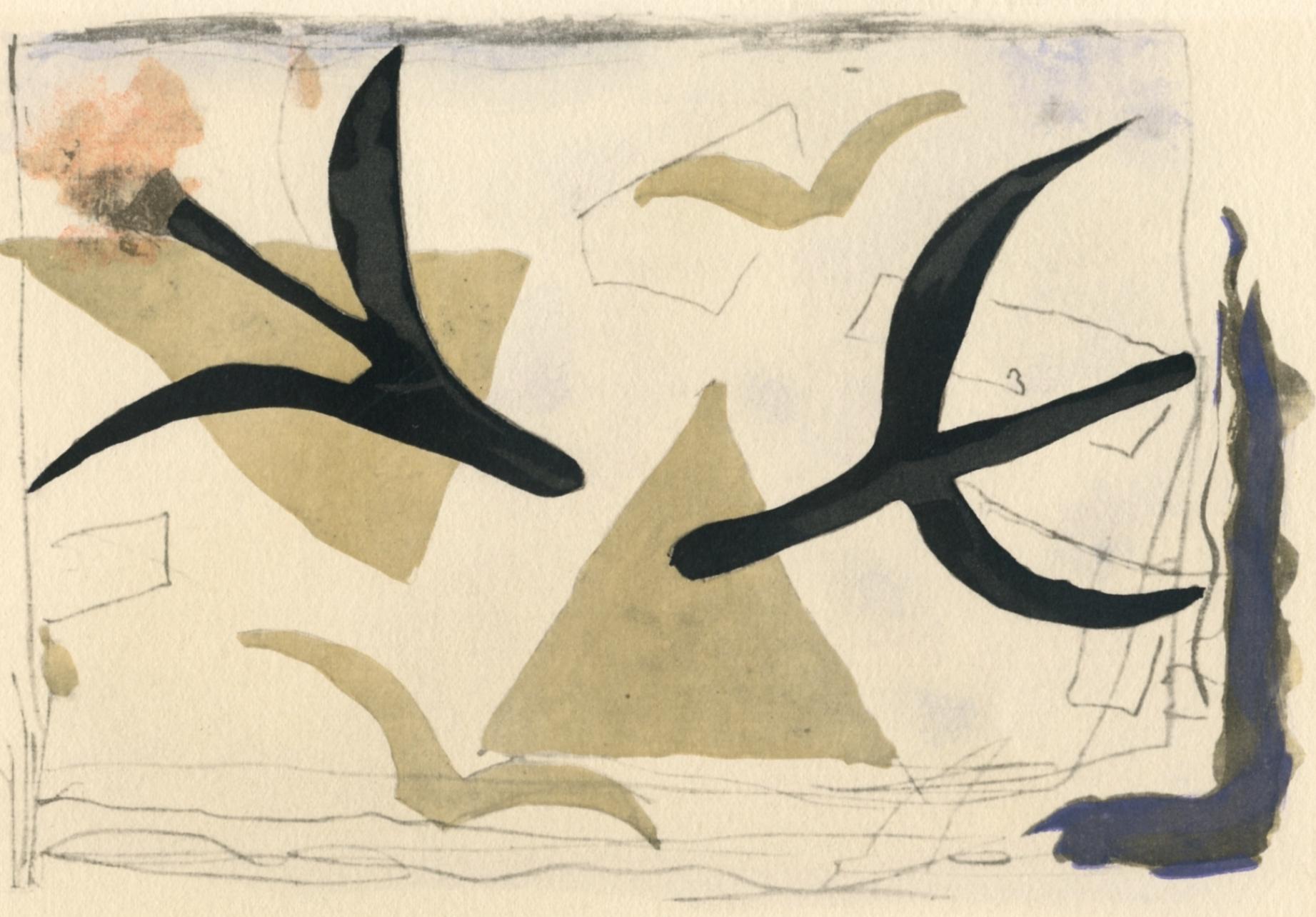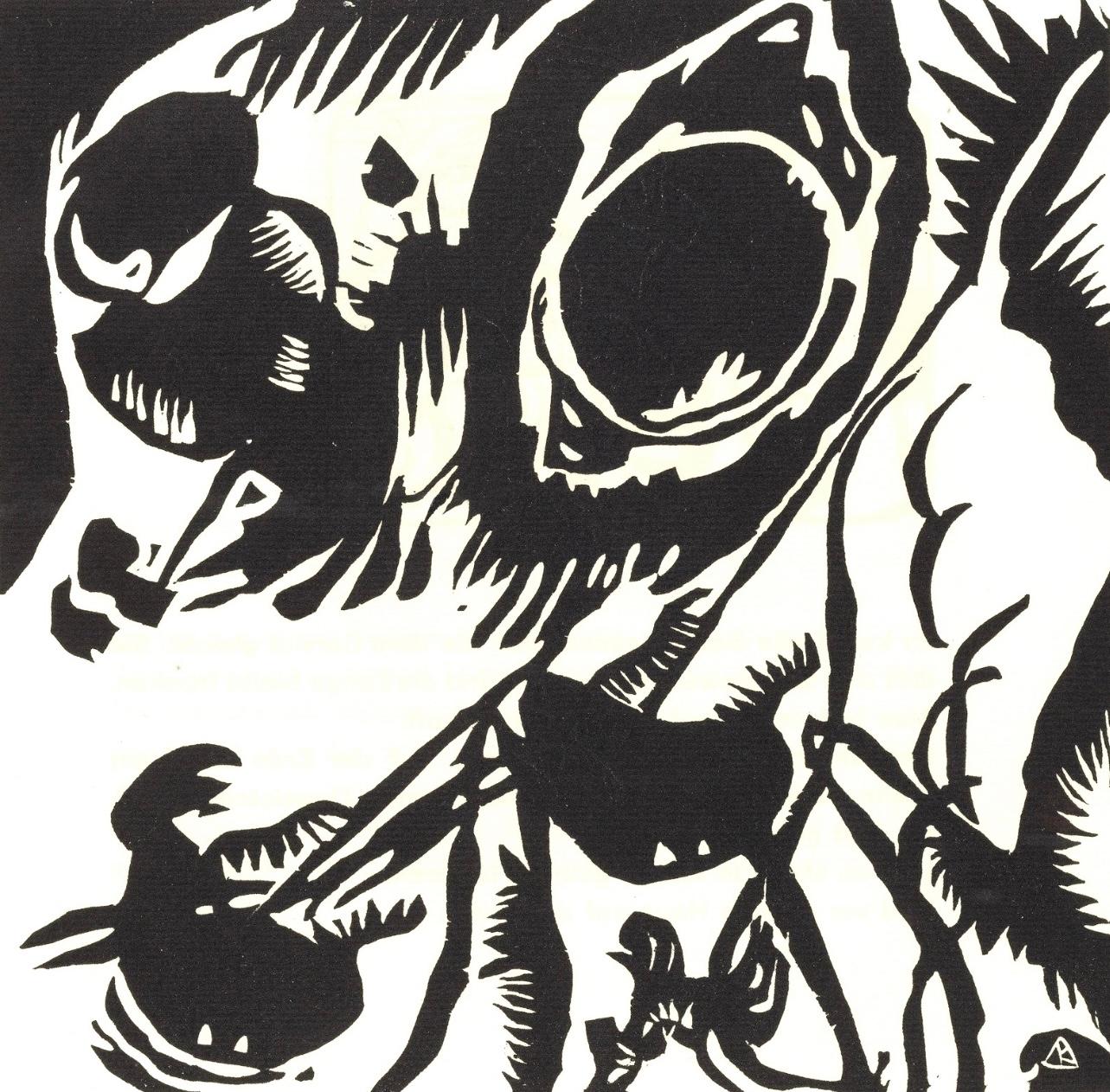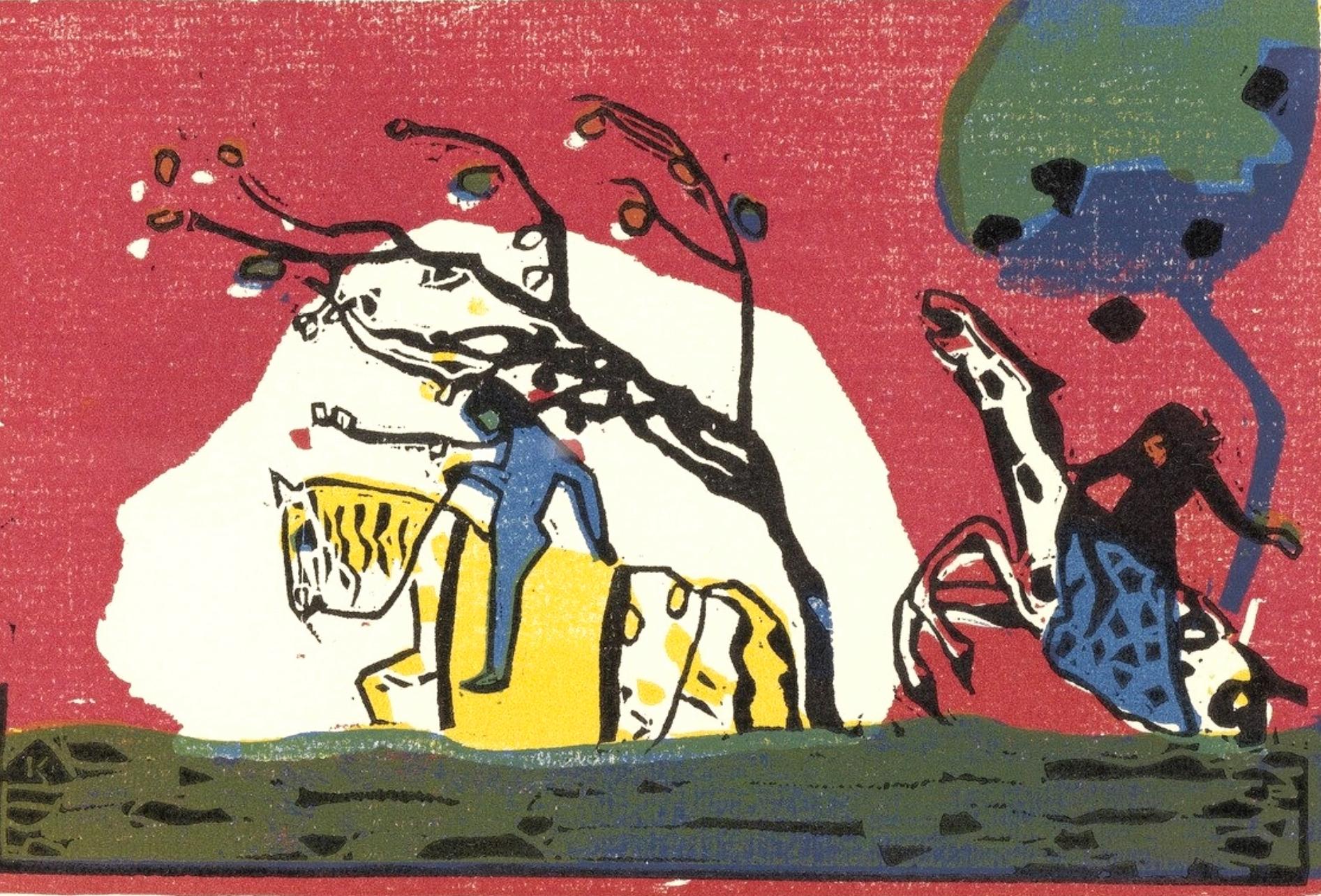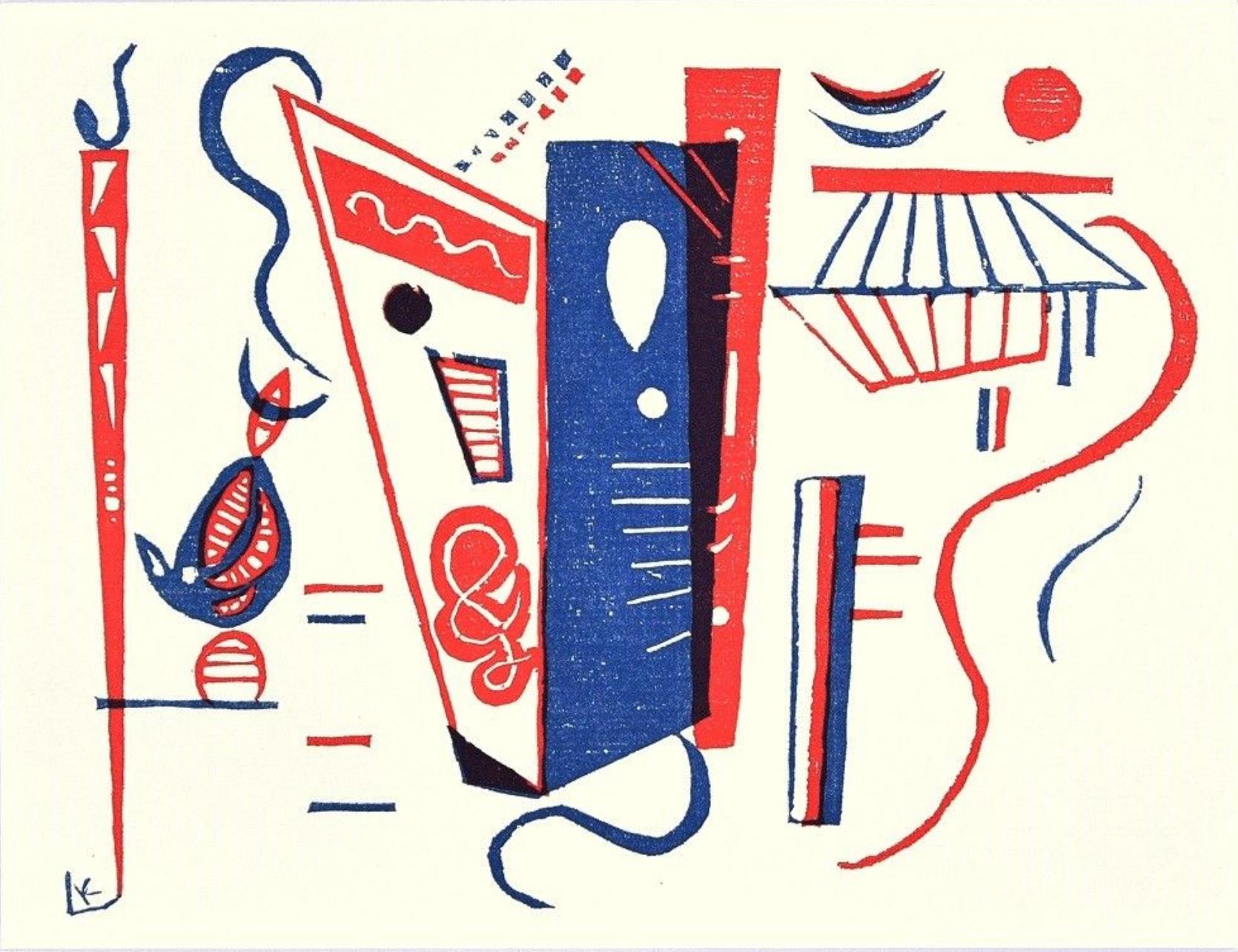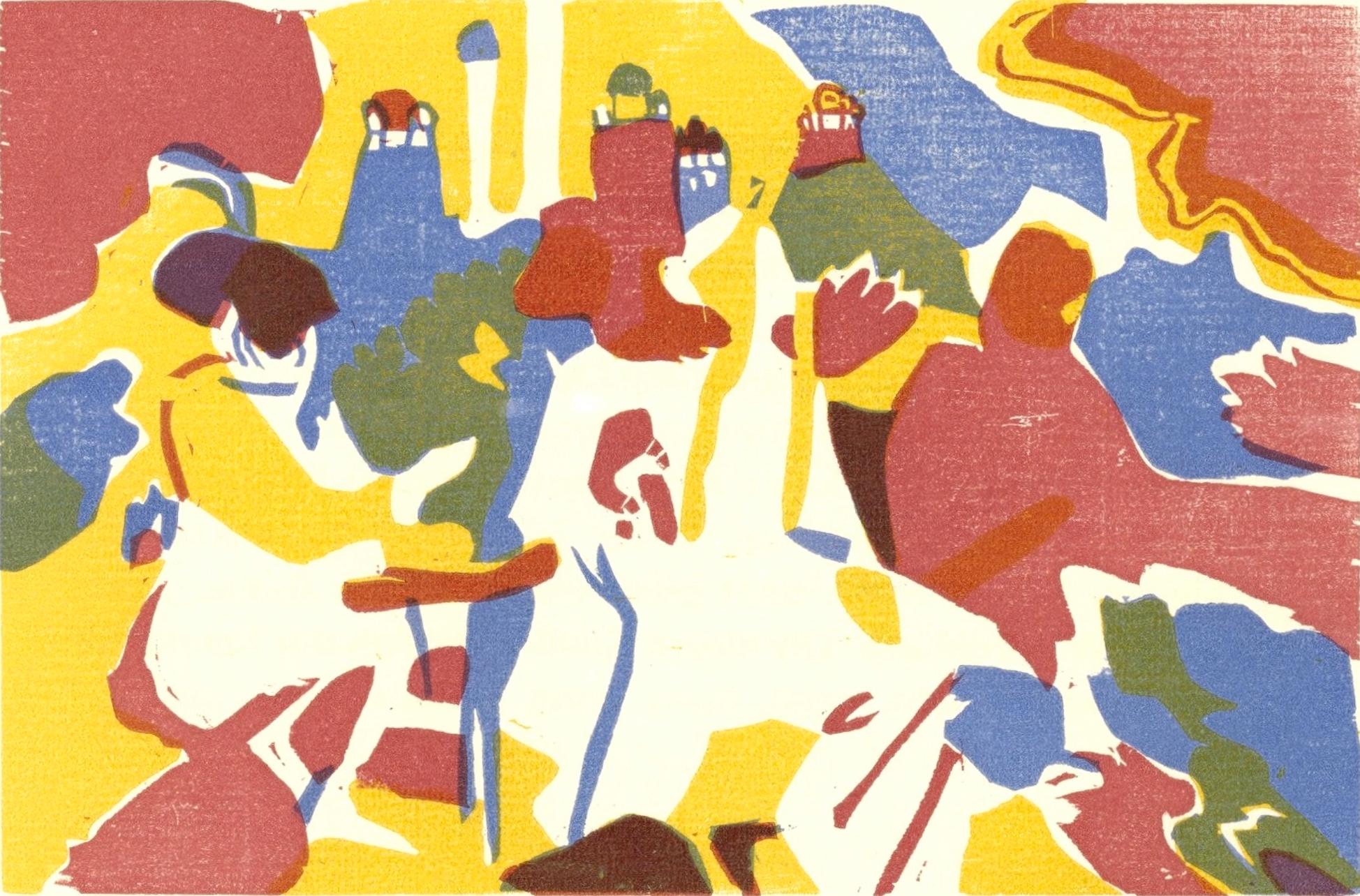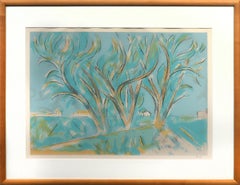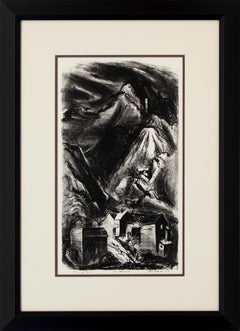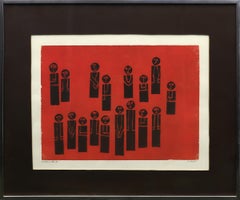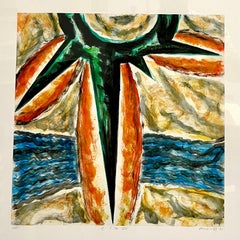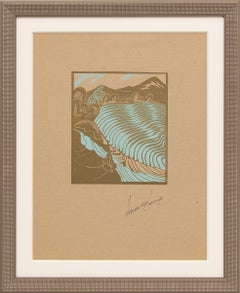
Pirouetting Paddies, Rice Terraces, 1940s Modernist Colored Woodcut Print
View Similar Items
Want more images or videos?
Request additional images or videos from the seller
1 of 10
Auction endedBrowse Current Auctions
Eve DrewelowePirouetting Paddies, Rice Terraces, 1940s Modernist Colored Woodcut Print
About the Item
- Creator:Eve Drewelowe (1899 - 1989, American)
- Dimensions:Height: 21.125 in (53.66 cm)Width: 17.25 in (43.82 cm)Depth: 0.75 in (1.91 cm)
- Medium:
- Movement & Style:
- Period:
- Condition:very good to excellent vintage condition.
- Gallery Location:Denver, CO
- Reference Number:Seller: DCG-212061stDibs: LU2736615442
Eve Drewelowe
From her earliest memory, Eve Drewelowe wanted to be an artist, and she became the first student to receive a masters of fine arts from the University of Iowa. After graduation, she went with her new husband to Boulder, Colorado, where she soon found herself in the role of dean’s wife. Eventually that responsibility and its “chores” proved to be too restrictive. After a health crisis, Drewelowe had a self-described “reincarnation” in which she resolved to make a place for her creativity. Naturally effusive, she yet valued being alone, and her strong feelings for life were expressed in her exuberant paintings. Growing up on an Iowa farm, Drewelowe developed a love for the land from her “environmentalist” father, who died when she was eleven. Subsequently, The Dean of the Graduate School at Iowa served as a father-figure when he facilitated her entry into the graduate program in art. Seemingly skeptical, Carl Seashore secretly wanted the young woman to “establish a first in the history of art training across the nation,” as the artist would later reminisce. Drewelowe graduated in 1924, and she later was a benefactor of what became one of the nation’s leading college art programs. At college, Drewelowe met and married a political science student, Jacob van Ek. Accepting a teaching position at the University of Colorado, van Ek moved to Boulder with his bride, who pursued her interest by helping found the Boulder Artists’ Guild. In 1928-1929, they traveled around the world to twenty-three countries for thirteen months, during which Drewelowe filled seven sketchbooks. With her husband now a dean, she threw herself into remodeling their house, a domestically acceptable creative project. Balancing her art and her duties as a dean’s wife, Drewelowe felt increasing frustration, and her health began to suffer. In the catalogue of a 1988 retrospective, she gave voice to her desire for self-determination: “Housewife! What an odious word! First! Foremost! Always! My waking thought from an embryo was on my need to be an artist!” Traveling to New York for her second solo exhibition in 1940, she stopped at the Mayo Clinic, where she was diagnosed as having a gastric polyp. This experience led to a new dedication to her painting, a complete turnaround in which she called her “reincarnation.” Inspired by the Rocky Mountains, she painted animated landscapes that pulsated with energy -- as if still in motion from generative forces. With a rainbow palette, Drewelowe created visionary scenes by intensifying colors in lively, rippling patterns. ©David Cook Galleries, LLC
About the Seller
5.0
Platinum Seller
These expertly vetted sellers are 1stDibs' most experienced sellers and are rated highest by our customers.
Established in 1979
1stDibs seller since 2013
265 sales on 1stDibs
Typical response time: 3 hours
More From This SellerView All
- Trees in Ranchitos II, New Mexico, 1970s Color Lithograph Landscape with TreesBy Andrew Michael DasburgLocated in Denver, CO"Tree in Ranchitos II" (New Mexico) is a lithograph initialed lower right by artist Andrew Michael Dasburg (1887-1979) from 1975. Presented in a custom frame measuring 30 ½ x 36 ¼ inches. Image size is 16 ½ x 23 ¼ inches. About the Artist: Born France, 1887 Died New Mexico, 1979 Andrew Dasburg was born in Paris, but emigrated to New York City in 1892 with his mother. A childhood sickness left him lame, and his artistic propensities were first recognized by a teacher at the crippled children’s school. She enrolled him in the Art Students League in 1902. There he studied under Kenyon Cox, Frank Vincent Dumond, and Birge Harrison. Later, he began taking night classes from Robert Henri at the New York School of Art. Dasburg spent 1908-1910 in Paris, where he was introduced to the great impressionist painters Matisse and Cezanne. Inspired by the work of the European modernists, Dasburg returned to the United States, where he moved to Woodstock, New York. In Woodstock, he and his wife, Grace Mott Johnson, lived with Morgan Russell...Category
1970s American Modern Landscape Prints
MaterialsLithograph, Archival Paper
- 1940s Vertical American Modern Mining Town Landscape Lithograph, Mountain SceneBy Otis DozierLocated in Denver, COLithograph titled "Mining Town" by Otis Dozier (1904-1987) from 1940. Modernist scene of a mountain mining town with several buildings at the base of the mountain. Presented in a custom black frame, outer dimensions measure 25 ½ x 18 ⅜ x ¼ inches. Image sight size is 16 ¼ x 9 ½ inches. Print is clean and in very good condition - please contact us for a detailed condition report. Provenance: Private Collection, Denver, Colorado Expedited and international shipping is available - please contact us for a quote. About the Artist: Born in Forney, Texas, Otis Marion Dozier was raised on a farm in Mesquite, Texas. Dozier was a muralist, potter, lithographer, sculptor, and painter. Dozier was a member of a group of Texas regionalist artists known as the "Dallas Nine." His surroundings in Texas became the focus of much of his art. Dozier’s first artistic training took place in the early 1920’s when his family moved to Dallas. He studied under Vivian Aunspaugh, Cora Edge, and Frank Reaugh...Category
1940s Abstract Abstract Prints
MaterialsPaper, Lithograph
- Mid Century Modern Woodblock Print, Red Black Group of Figures, American ModernBy Margo HoffLocated in Denver, COWoodblock on colored paper by Margo Hoff (1910-2008) titled 'Observers' of a black and red abstract scene with seventeen figures whose arms are in various positions, looking out at t...Category
20th Century American Modern Abstract Prints
MaterialsPaper, Woodcut
$1,360 Sale Price20% Off - Grand Lake, Yacht Races, Colorado Mountain Lake, 1930s Black White PrintBy Arnold RönnebeckLocated in Denver, COGrand Lake, Colorado, Yacht Races, vintage 1930s modernist, WPA era black and white lithograph by Colorado artist, Arnold Ronnebeck (1885-1947). Lake with ...Category
1930s American Modern Landscape Prints
MaterialsLithograph
- Ruins of Central City, Vintage 1935 Framed Colorado Modernist LandscapeBy Vance KirklandLocated in Denver, COVintage lithograph titled "Ruins of Central City 31/70" is a modernist landscape with decaying buildings and mountains by Vance Hall Kirkland, from 1935. Presented in a custom black frame with archival materials, outer dimensions measure 25 ⅞ x 29 ⅜ x ⅝ inches. Image sight size is 14 x 17 ¾ inches. Painting is clean and in very good vintage condition - please contact us for a detailed condition report. Provenance: Private collection, Denver, Colorado Expedited and international shipping is available - please contact us for a quote. About the Artist: Variously referred to as the "Father of Modern Colorado Painting", "Dean of Colorado Artists", and "Colorado’s pre-eminent artist," Kirkland was an inventive, visionary painter who spent fifty-two years of his fifty-four-year career in Denver. Of the approximately 1,200 paintings he created, about 550 from the first half of his career (1927-1953) are water-based media: acquarelle, gouache, casein and egg tempera, with a few oils. In the latter half of his career (1953-1981) he used oil and his unique oil and water mixture. He also produced five hundred drawings and some ten prints, mostly lithographs on stone, while also engaged in teaching full-time for most of the period. To show people "something they have never seen before and new ways to look at things," he felt he needed to preserve his artistic freedom. Consequently, he chose to spend his entire professional career in Denver far removed from the established American art centers in the East and Midwest. "By minding my own business and working on my own," he said, "I think it was possible to develop in this part of the country… I’ve developed my kind of work [and] I think my paintings are stronger for having worked that way." The geographical isolation resulting from his choice to stay in Colorado did not impede his creativity, as it did other artists, but in fact contributed to his unique vision. The son of a dentist, who was disappointed with his [son’s] choice of art as a career, Kirkland flunked freshman watercolor class in 1924 at the Cleveland School of Art (now the Cleveland Institute of Art) for putting colors into his landscapes that did not exist in nature and for competing colors. Not dissuaded, he won first prize for his watercolors in his junior and senior years. [While in Cleveland,] he studied with three influential teachers. Henry Keller, included in the prestigious New York Armory Show in 1913, introduced him to designed realism which he later used in his Colorado landscapes in the 1930s and 1940s. His other teachers were Bill Eastman, who studied with Hans Hofmann and appreciated all the new movements in modern art, and Frank Wilcox, a fine watercolorist. While a student at the Cleveland School of Art, Kirkland concurrently took liberal arts courses at Western Reserve and the Cleveland School of Education and taught two freshman courses in watercolor and design, receiving his diploma in painting from the school in 1927 by doing four years of work in three. The following year he received a Bachelor of Education in Art degree from the same institution. In 1929 he assumed the position of founding director of the University of Denver’s School of Art, originally known as the Chappell School of Art. He resigned three years later when the university reneged on its agreement to grant its art courses full recognition toward a Bachelor of Arts degree. His students prevailed on him to continue teaching, resulting in the Kirkland School of Art which he opened in 1932 at 1311 Pearl Street in Denver. The building, where he painted until his death in 1981, formerly was the studio of British-born artist, Henry Read, designer of the City of Denver Seal and one of the original thirteen charter members of the Artists’ Club of Denver, forerunner of the Denver Art Museum. The Kirkland School of Art prospered for the next fourteen years with its courses accredited by the University of Colorado Extension Center in Denver. The teaching income from his art school and his painting commissions helped him survive the Great Depression. The U.S. Treasury Department’s Section of Fine Arts commissioned from him two post office murals, Cattle Roundup (1938, Eureka, Kansas), and Land Rush (1940, Sayre, Oklahoma). He also did murals for several Denver clients: the Gerald Hughes mansion (1936, later demolished), Arthur Johnson home (1936-37, Seven Drinks of Man), Albany Hotel (1937, later demolished), Neustetter’s Department Store (1937, "History of Costume," three of five saved in 1987 before the building interior was demolished in advance of its condo conversion), and the Denver Country Club (1945, partially destroyed and later painted over). In 1953 the Ford Times, published by the Ford Motor Company, commissioned Kirkland along with fellow Denver artists, William Sanderson and Richard Sorby, to paint six watercolors each for the publication. Their work appeared in articles [about] Colorado entitled, "Take to the High Road" (of the Colorado Rockies) by Alicita and Warren Hamilton. Kirkland sketched the mountain passes and high roads in the area of Mount Evans, Independence Pass near Aspen, and Trail Ridge Road in Rocky Mountain National Park. In 1946 Kirkland closed his art school when the University of Denver rehired him as director of its School of Art and chairman of the Division of Arts and Humanities. In 1957 the University gave him its highest honor – the "University Lecturer Award." When he retired in 1969 as Professor of Art Emeritus to become a full-time painter, the School of Arts was the university’s largest undergraduate department. In 1971 Governor John Love presented Kirkland the State of Colorado Arts and Humanities Award. In addition to his dual positions as artist and teacher in Denver for more than half a century, he served the Denver Art Museum as a trustee, chairman of the accessions committee, member of the exhibitions committee, curator of European and American art, and honorary curator of painting and sculpture. He also won the battle with the museum’s old guard to establish a department of modern and contemporary art. Additionally, he was one of the fifty-two founding members of the Denver Artists Guild which included most of Colorado’s leading artists who greatly contributed to the state’s cultural history. Kirkland developed five major painting periods during his life encompassing various series with some chronological overlap: Designed Realism (1927-1944); Surrealism (1939-1954); Hard Edge Abstraction, including the Timberline Abstraction Series (1947-1957); Abstract Expressionism with four series – Nebulae, Roman, Asian, and Pure Abstractions (1951-1964); and the Dot Paintings with five series – Energy of Vibrations, Mysteries, Explosions, Forces, and Pure Abstractions (1963-1981). Nevadaville (1931), a watercolor, belongs to Kirkland’s initial period of Designed Realism. Adapting nature by redesigning the realism he saw on location in Colorado allowed him to be "more concerned with the importance of the painting rather than the importance of the landscape." He noted that the rhythms his Cleveland teacher, Henry Keller, "found in nature created a certain movement in his paintings… [that moved] away from the static element of a lot of realistic, representational painting." Kirkland, along with fellow watercolorist Elisabeth Spalding, were some of the first Denver artists interesting themselves in Colorado’s nineteenth-century mining towns west of Denver. They offered an alternative to the overwrought cowboy and Indian subject matter of the previous generation; while the human and architectural components of the mining towns provided a welcome break from the predominant nineteenth-century landscape tradition. Vibrations of Two Yellows in Space (1970), one of Kirkland’s small subseries of "Open Sun Paintings," occupies the final phase in his first series of dot paintings, Energy of Vibrations in Space (1963-1972). Many pieces in the series incorporate his unique mixture of oil paint and water which he developed in the early 1950s. The work in the subseries – a challenge to the viewer’s optic nerve – constitutes his contribution to the international realm of Op Art. Recalling the theory of pulsating galaxies and the universe, he used dots applied with dowels of different sizes to surround and leave round open spaces letting the gradient background show through. Because of the color contrast between the two, the "suns" either recede into the background or jump out in the foreground, creating the powerful pulsing effect. During his lifetime he assembled on a limited budget an extensive collection of fine and decorative art and furniture. His collecting passion dated from his student days when he used his prize money from the Cleveland School of Art to purchase a watercolor by William Eastman and a now-famous set of Russian musician figures by Alexander Blazys, both of whom were his professors. After Kirkland’s death, the Denver Art Museum received a large bequest that included paintings by Roberto Matta, Gene Davis, Charles Burchfield, and Richard Anuszkiewicz (the two latter-named also alumni of the Cleveland Institute of Art); prints by Arthur B. Davies, Roberto Matta, Pablo Picasso, and Robert Rauschenberg; and a sculpture by Ossip Zadkine. Kirkland posthumously was the subject of a television documentary, "Vance Kirkland’s Visual Language," aired on over one hundred PBS television stations (1994-96), and in 1999 a six-scene biographical ballet choreographed by Martin Friedmann with scenario provided by Hugh Grant, founder and director of the Kirkland Museum of Fine & Decorative Art in Denver. Historic Denver also posthumously honored Kirkland as part of the Colorado 100. From 1997 to 2000 Kirkland’s solo exhibition was hosted by thirteen European museums: Fondazione Muduma, Milan; Sala Parpalló Museum Complex, València; Stadtmuseum, Düsseldorf; Frankfurter Kunstverein; Museum of Modern Art, Vienna; Kiscelli Múzeum and the Museum of Fine Arts, Budapest; Czech Museum of Fine Arts, Prague; National Museum, Warsaw; State Gallery of the Art of Poland, Sopot/Gdańsk, National Museum of Art, Kaunas, Lithuania; Latvian Foreign Art Museum, Riga; and the State Russian Museum, St. Petersburg. Solo Exhibitions: Denver Art Museum (1930, 1935, 1939-40, 1942, 1972, 1978-retrospective, 1988, 1998); Colorado Springs Fine Arts Center (1943); Knoedler & Company, New York (1946, 1948, 1952); Pogzeba Art Gallery, Denver (1959); Galleria Schneider, Rome (1960); Birger Sandzén Memorial Gallery, Lindsborg, Kansas (1964-65,1977); Genesis Galleries, Ltd., New York (1978); Valhalla Gallery, Wichita, Kansas (1979); Inkfish Gallery, Denver (1980); Colorado State University, Fort Collins (1981- memorial exhibition); Boulder Center for the Visual Arts (1985); University of Denver, Schwayder Art Gallery (1991). Group Exhibitions (selected): "May Show," Cleveland Museum of Art (1927-28); "Western Annuals," Denver Art Museum (1929-1957, 1964, 1966, 1968, 1971); "International Exhibition of Watercolors, Pastels, Drawings and Monotypes," Art Institute of Chicago (1930-1946); "Abstract and Surrealist American Art," Art Institute of Chicago (1947-48, traveled to ten other American museums); "Midwest Artists Exhibition," Kansas City Art Institute (1932, 1937, 1939-1942); Dallas Museum of Art (1933, 1960); San Diego Museum of Art (1941); "Artists for Victory," Metropolitan Museum of Art (1942); "United Nations Artists in America," Argent Galleries, New York (1943); "California Watercolor Society," Los Angeles County Museum (1943-1945); "Survey of Romantic Painting," Museum of Modern Art, New York (1945); New Mexico Museum of Art, Santa Fe (1945, 1951); Knoedler & Company, New York (1946-57; co-show with Max Ernest, 1950; co-show with Bernard Buffet, 1952); Joslyn Art Museum, Omaha (1948, 1956); Philbrook Art Center, Tulsa, Oklahoma (1951); "Contemporary American Painting," University of Illinois, Urbana (1952); University of Utah, Salt Lake (1952-53); Oakland Art Museum (1954-55); "Reality and Fantasy, 1900-54," Walker Art Center, Minneapolis (1954); "Art U.S.A.," Madison Square Garden, New York (1958); Roswell Museum and Art Center, New Mexico (1961); Burpee Art Museum, Rockford, Illinois (1965-68); University of Arizona Art...Category
1930s American Modern Landscape Prints
MaterialsPaper, Lithograph
$3,400 Sale Price20% Off - Comanche Dance, Ildefonso Pueblo, New Mexico Southwest Framed EtchingBy Gene KlossLocated in Denver, COComanche Dance at San Ildefonso Pueblo (New Mexico). Etching and drypoint, artist's proof from an edition of 50 prints. Presented in a custom frame, outer dimensions measure 22 ¼ x 18 ½ x ½ inches. Image size is 11 ¾ x 14 ½ inches. Print is clean and in very good vintage condition - please contact us for a detailed condition report. Expedited and international shipping is available - please contact us for a quote. About the Artist: Gene (Alice Geneva) Kloss is considered one of America’s master printmakers. She was born in Oakland, California and established herself as an artist on the West coast. Kloss was introduced to etching by Perham Nahl while at UC Berkley. She graduated in 1924, and in 1925 married poet Phillips Kloss. In her late twenties, Kloss moved to Taos, New Mexico and began her life’s work of the New Mexican landscape and peoples. It was at this time that she received national acclaim. Her artwork exudes an unmistakable content and style. Enchanted by the architecture, mountainous landscapes and rituals of the inhabitants, Kloss captured the beauty of the Southwest and surrounding areas. Her style was bold yet deftly simple, masterfully expressing the elusive Southwestern light...Category
1980s American Modern Figurative Prints
MaterialsDrypoint, Etching
$1,525 Sale Price53% Off
You May Also Like
- Monoprint Lithograph American Modernist Gregory Amenoff Abstract ExpressionistBy Gregory AmenoffLocated in Surfside, FLGregory Amenoff (Contemporary American abstract painter, b. 1948), Monotype Monoprint (1990) Hand signed in pencil lower right plate: 16 x 16 inches frame dimensions: 35 1/8 x 29 1/8 x 1 5/8 inches, wood frame with glazing Provenance: Corporate Collection of Bank BNP Paribas Gregory Amenoff is a painter who lives in New York City and Ulster County, New York. He is the recipient of numerous awards from organizations including the American Academy of Arts and Letters, National Endowment for the Arts, New York State Council on the Arts and the Tiffany Foundation. He has had over fifty one-person painting exhibitions in museums and galleries throughout the United States and Europe. His work is in the permanent collections of more than thirty museums, including the Whitney Museum of American Art, the Museum of Fine Arts in Boston, the Museum of Modern Art in New York and the Metropolitan Museum of Art. His work has the influence of both Abstract Expressionism and Pop Art in it, biomorphic forms in rich hues and thick textures with heightened colors and abstracted, organic forms, late American Modernism. He moved to New York in 1979, the artist rose to critical acclaim in the 1980s alongside Terry Winters, Bill Jensen, and Katherine Porter. The artist lives and works between New York, NY and his Hudson Valley residence. He was a collaborating artist illustrating Bradford Morrow, Bestiary along with Joe Andoe, James Brown, Vija Celmins, Louisa Chase, Eric Fischl, Jan Hashey, Michael Hurson, Mel Kendrick, James Nares, Ellen Phelan, Joel Shapiro, Kiki Smith, David Storey, Michelle Stuart, Richard Tuttle, Trevor Winkfield, Robin Winters. Linoleum cuts with pochoir and woodcuts for the Grenfell Press, New York. Amenoff served as President of the National Academy of Design from 2001-2005. He is a founding board member of the CUE Art Foundation in New York City and serves as the CUE Art Foundation's Curator Governor. Amenoff has taught at Columbia for the last eighteen years, where he holds the Eve and Herman Gelman Chair of Visual Arts and is currently the Chair of the Visual Arts Division in the School of the Arts. He is currently the Vice-President of the National Academy. In 2011 he received the John Solomon Guggenheim Fellowship. Museum Collections Albright-Knox Art Gallery; Buffalo, NY Art Institute of Chicago; IL Baltimore Museum of Art; Brooklyn Museum of Art; Brooklyn, NY Butler Institute of American Art; Youngstown, OH Cleveland Museum of Art; Cleveland, OH Currier Gallery of Art; Manchester, NH Frances and Sidney Lewis Foundation; Richmond, VA Hood Museum of Art; Hanover, NH Honolulu Academy of Art; Honolulu, HW Kemper Museum of Contemporary Art; Kansas City, MO Maier Museum of Art; Lynchburg, VA Metropolitan Museum of Art; New York, NY Milwaukee Museum of Art; Milwaukee, WI Minneapolis Institute of Art; MN Muscarelle Museum of Art, College of William and Mary; Williamsburg, VA Museum of Fine Arts; Boston, MA Museum of Modern Art; New York, NY National Museum of American Art; Washington, DC Neuberger Museum, State University of New York at Purchase; NY New York Public Library, Spencer Collection...Category
1980s American Modern Abstract Prints
MaterialsLithograph, Monoprint, Monotype
- Dark House (Philadelphia).By Earl HorterLocated in Storrs, CTc. 1932. Aquatint. 10 1/4 x 11 (sheet 12 5/8 x 15 1/2). A rich impression printed with plate tone on countermarked French wove paper. Unsigned; annotated 'Dark House (Aqua)' in Horter's hand. Another impression is in the Library of Congress. Housed in a 16 x 20-inch archival mat, suitable for framing. Earl Horter...Category
Mid-20th Century American Modern Landscape Prints
MaterialsEtching, Aquatint
$250 Sale Price37% Off - Charing Cross Bridge from My WindowBy Joseph PennellLocated in Storrs, CTCharing Cross at Night. 1909. Mezzotint. Wuerth 510. 11 7/8 x 10 (sheet 15 x 10 3/4). Edition probably 30. Printed on 'Rome'cream laid paper, probably fr...Category
Early 20th Century American Modern Landscape Prints
MaterialsResin, Aquatint
$3,600 Sale Price20% Off - Standard Oil Building.By Joseph PennellLocated in Storrs, CTStandard Oil Building. 1923. Etching. Wuerth 817. 12 1/4 x 9 1/4 (sheet 13 1/2 x 10 1/16). Edition probably 50. A glowing impression, printed by the artist on antique cream wove paper. Signed and annotated 'imp' in pencil. Housed in a 20 x 16-inch archival mat proof printed by the artist. $875. 26 Broadway" is the home of the Standard Oil...Category
Early 20th Century American Modern Landscape Prints
MaterialsEtching
- Grand Canal, America (Electrical Buildings at Night)By Gerald GeerlingsLocated in Storrs, CTCzestochowski 31. 11 3/4 x 8 7/8 (sheet 12 x 18). Edition 100. Presentation print for the Chicago Society of'Chicago Fair 1933. A rich impression with t...Category
Mid-20th Century American Modern Landscape Prints
MaterialsAcrylic, Drypoint
- From the Weather Bureau. New York, New York.By Stow WengenrothLocated in Storrs, CT"From the Weather Bureau. February 1940. Lithograph printed in black and cream. Stuckey catalog 106. state i. Two stone printing. 10 1/8 x 17 (sheet 16 x 21 5/8). Edition 40 in this ...Category
1940s American Modern Landscape Prints
MaterialsLithograph
Recently Viewed
View AllMore Ways To Browse
Salvador Dali Normandy
W L Wyllie
Urbain Huchet On Sale
Le Girafe En Feu
Luigi Kasimir On Sale
Joseph Pennell On Sale
Hugo Pondz Prints
Peter Max Guitar
Roy Lichtenstein Red Barn
Simon Tozer
Tall French End Table 18 Inches Wide
Charly Rock
Tavik Frantisek Simon
Tavik Simon
Stone Te
Thomas Moran Lithograph
Mens Metallic Suit
Margaret Macdonald
